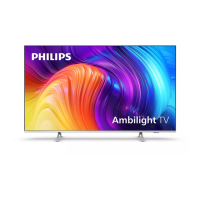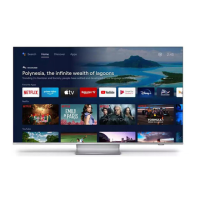
Do you have a question about the Philips 50PUS8506 and is the answer not in the manual?
| Screen Size | 50 inches |
|---|---|
| Display Technology | LED |
| Smart TV | Yes |
| Operating System | Android TV |
| HDMI Ports | 4 |
| USB Ports | 2 |
| Ambilight | 3-sided |
| Refresh Rate | 60 Hz |
| Audio | 20W, Dolby Atmos |
| Bluetooth | Yes |
| Resolution | 3840 x 2160 |
| HDR | HDR10+, Dolby Vision |
| Wi-Fi | Yes |
| Processor | Quad Core |
Explains the main screen and channel organization.
Details about apps and the Philips TV Collection.
Instructions to open the main TV interface.
Information on updates for the TV's home screen.
Important safety instructions before using the TV.
Guidance on installing the TV stand or wall mount.
Advice on optimal TV placement for viewing and Ambilight.
Instructions for connecting the power cable.
Identification and function of remote control buttons.
Steps to connect the remote control via Bluetooth.
How to use voice commands for searching.
Explanation of the infrared sensor for remote operation.
Instructions for replacing remote control batteries.
How to clean the remote control properly.
How to turn the TV on, switch to standby, or power off.
Using the TV's physical buttons for basic operations.
Steps to install TV channels.
Managing and viewing lists of available channels.
How to sort channels by type or status.
Tuning to channels, switching, and locking.
Creating and managing custom channel lists.
Using Teletext features for information.
Using interactive TV services like HbbTV.
Guide to installing satellite channels.
Steps for installing terrestrial channels.
Copying channel lists between TVs.
Overview of connecting external devices.
Connecting audio systems via HDMI ARC.
Details on HDMI ports and quality.
Operating devices via TV remote.
Using Conditional Access Modules for premium channels.
Connecting audio systems.
Connecting mobile devices.
Connecting a Blu-ray player.
Pairing and managing Bluetooth devices.
Connecting headphones to the TV.
Connecting gaming consoles.
Connecting and using USB drives for storage.
Connecting and configuring a USB keyboard.
Viewing media from USB flash drives.
Connecting digital cameras.
Connecting camcorders via HDMI.
Connecting a computer for use as a monitor.
Setting up wired and wireless network connections.
Logging into a Google account for TV features.
Accessing premium apps from Philips TV Collection.
Overview of apps and their sources.
Using Google Play for movies, TV, music, and games.
Launching and closing applications.
Setting up app locks and parental controls.
Locking apps based on age rating.
Creating a profile to limit app access.
Checking TV storage usage and free space.
Using USB drives to extend storage.
Browsing websites using the TV's internet browser.
Exploring additional features of the internet browser.
Accessing TV functions quickly via the Quick Menu.
Switching between connected input sources.
Starting playback from connected devices.
Configuring settings for specific TV inputs.
Renaming and assigning types to connected devices.
Updating the list of connected devices.
Information on connecting the TV to a network.
Pairing and managing Bluetooth devices.
Adjusting picture settings like style, colour, contrast, sharpness.
Adjusting audio settings like style, volume, and placement.
General settings for Ambilight customization.
Power saving features like screen off and light sensor.
General TV configurations and setup.
Configuring time, region, and language settings.
Managing installed apps and storage.
Features for accessibility needs.
Setting up app locks and parental controls.
Viewing media from network storage.
Adding and viewing media files in favourites.
Accessing popular and recently played media.
Viewing media from USB drives.
Opening and playing video files.
Settings for video playback.
Opening and viewing photo folders.
Viewing individual photos and slideshows.
Options for viewing 360-degree photos.
Controls for playback of 360 photos.
Accessing folders with 360 photos.
Opening and playing music files.
Settings for music playback.
Requirements for using the TV Guide.
Information on how TV Guide data is obtained.
Navigating and using the TV Guide features.
Selecting and watching a program from the guide.
Displaying detailed information about a program.
Finding programs based on genre.
Viewing and managing set reminders.
Scheduling TV program recordings.
Requirements and process for recording TV broadcasts.
Prerequisites for recording TV programs.
Starting an immediate recording.
Scheduling future TV program recordings.
Resolving overlapping recording schedules.
Adjusting recording end time buffer.
Scheduling recordings without TV guide data.
Pausing and resuming live TV broadcasts.
Requirements for using the pause TV function.
Using the mobile app for TV control and media.
Casting apps and media from mobile devices.
Requirements for playing games on the TV.
Connecting wireless gamepads.
Playing games from connected consoles.
Setting Ambilight effects based on video, audio, or presets.
Using Ambilight for ambient lighting while TV is in standby.
Wake-up experience using Ambilight, music, and weather.
Simulating sunset to aid sleep, followed by standby.
Synchronizing Ambilight with Philips Hue bulbs.
TV recommendations for programs and videos.
Agreeing to terms for personalized recommendations.
Viewing currently popular TV programs.
Renting movies from online video stores.
Accessing the Netflix app for streaming services.
Overview of Alexa voice control features on the TV.
Using Alexa Skills for extended voice control.
Setup and usage instructions for Alexa voice control.
Updating TV software via internet or USB.
Instructions for updating software online.
Instructions for updating software using a USB drive.
Searching for Over-the-air Download software updates.
Viewing the current TV software version.
Information on energy efficiency and disposal.
Electrical specifications and power consumption.
Details about the TV's operating system.
Tuner and reception specifications.
Information on screen size and resolution.
List of supported video resolutions and refresh rates.
List of supported computer and video resolutions.
Ports and connections on the side of the TV.
Ports and connections on the bottom of the TV.
Specifications for the TV's audio output power.
Information on Dolby MS12 V2.5 audio processing.
Support for Dolby Atmos audio technology.
Information on DTS-HD audio processing.
Support for DTS Play-Fi wireless audio streaming.
Features for enhancing surround sound experience.
Feature for improving bass response in audio.
Feature for improving dialogue clarity in audio.
List of physical connections and wireless interfaces.
List of supported file systems for USB drives.
Supported media file containers, codecs, and subtitles.
Information on compatible media server software.
Benefits and process of registering the TV.
Navigating the TV's built-in help system.
Accessing help guides on external devices.
Solutions for common TV problems.
Accessing Philips online support and resources.
Contacting support and information on repair services.
Important safety instructions to prevent injury or damage.
Precautions against electrical hazards.
Warnings regarding physical handling and mounting.
Precautions to prevent TV tip-over.
Safety warnings related to batteries.
Instructions for cleaning and maintaining the TV screen.
Precautions against overheating due to poor ventilation.
Safety measures during thunderstorms.
Warnings about using headphones at high volumes.
Legal terms and conditions for using the TV.
Terms for using smart TV features and privacy policy.
Terms for using the Philips TV Collection apps.
Trademarks related to HDMI technology.
Trademarks related to Dolby Audio technology.
Trademarks related to Dolby Vision and Atmos.
Trademarks related to DTS-HD technology.
Trademarks related to DTS Play-Fi technology.
Trademark for Wi-Fi certification.
Trademark information for Kensington security products.
General statement about other trademarks.
Statement on third-party services and software changes.











